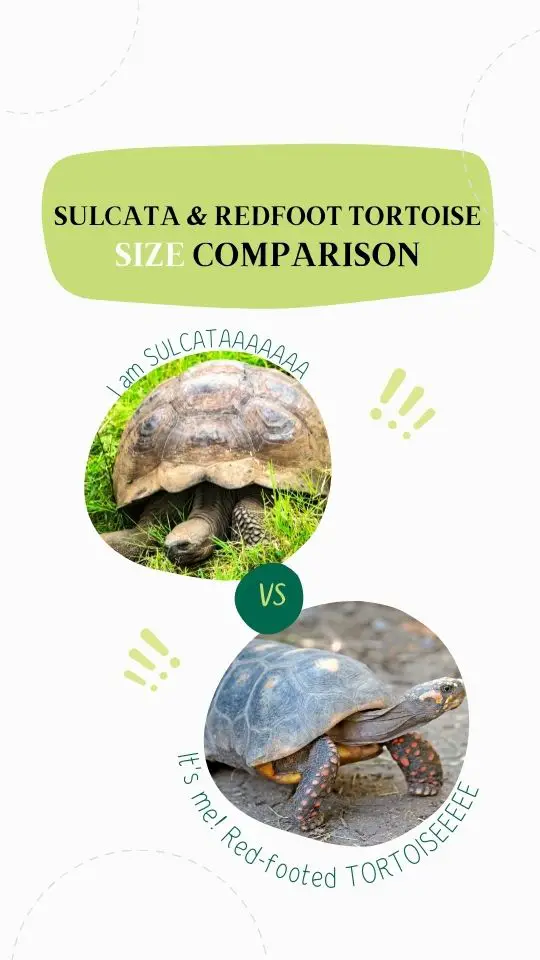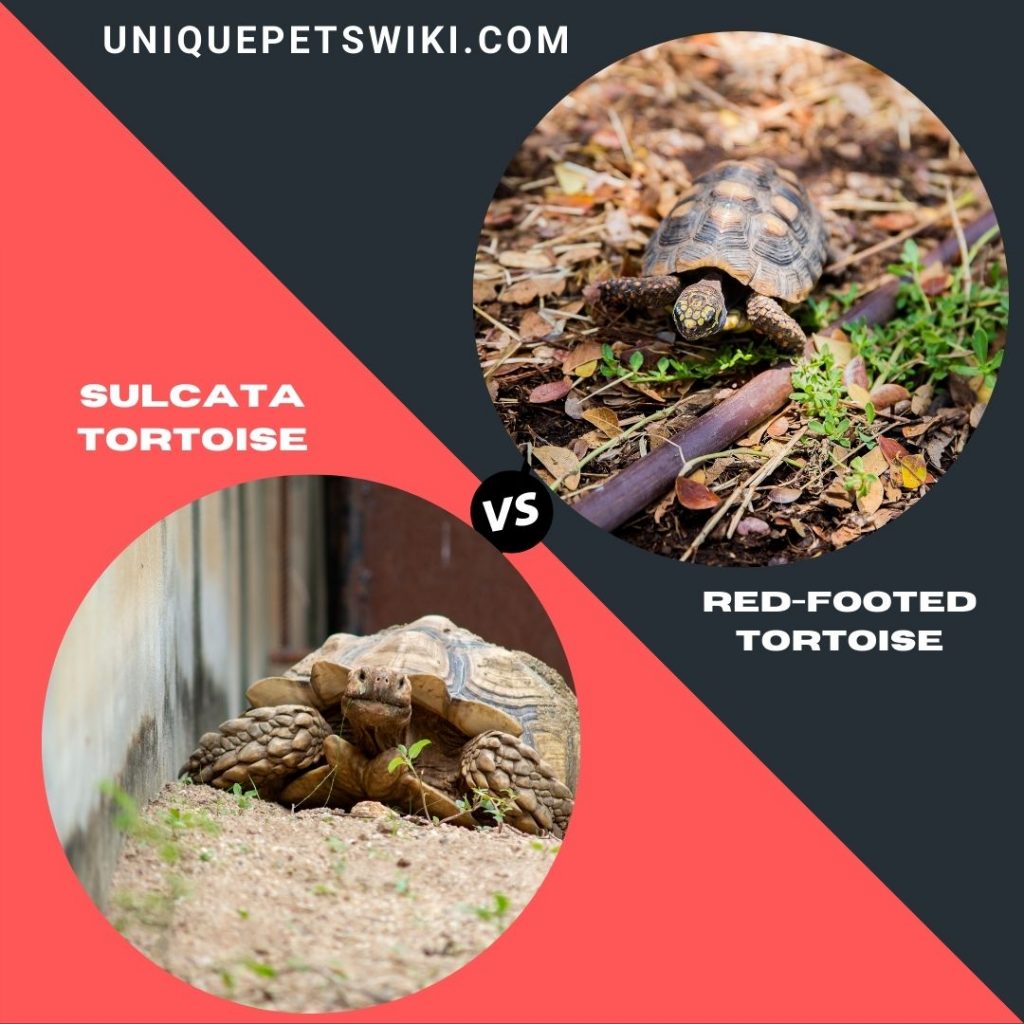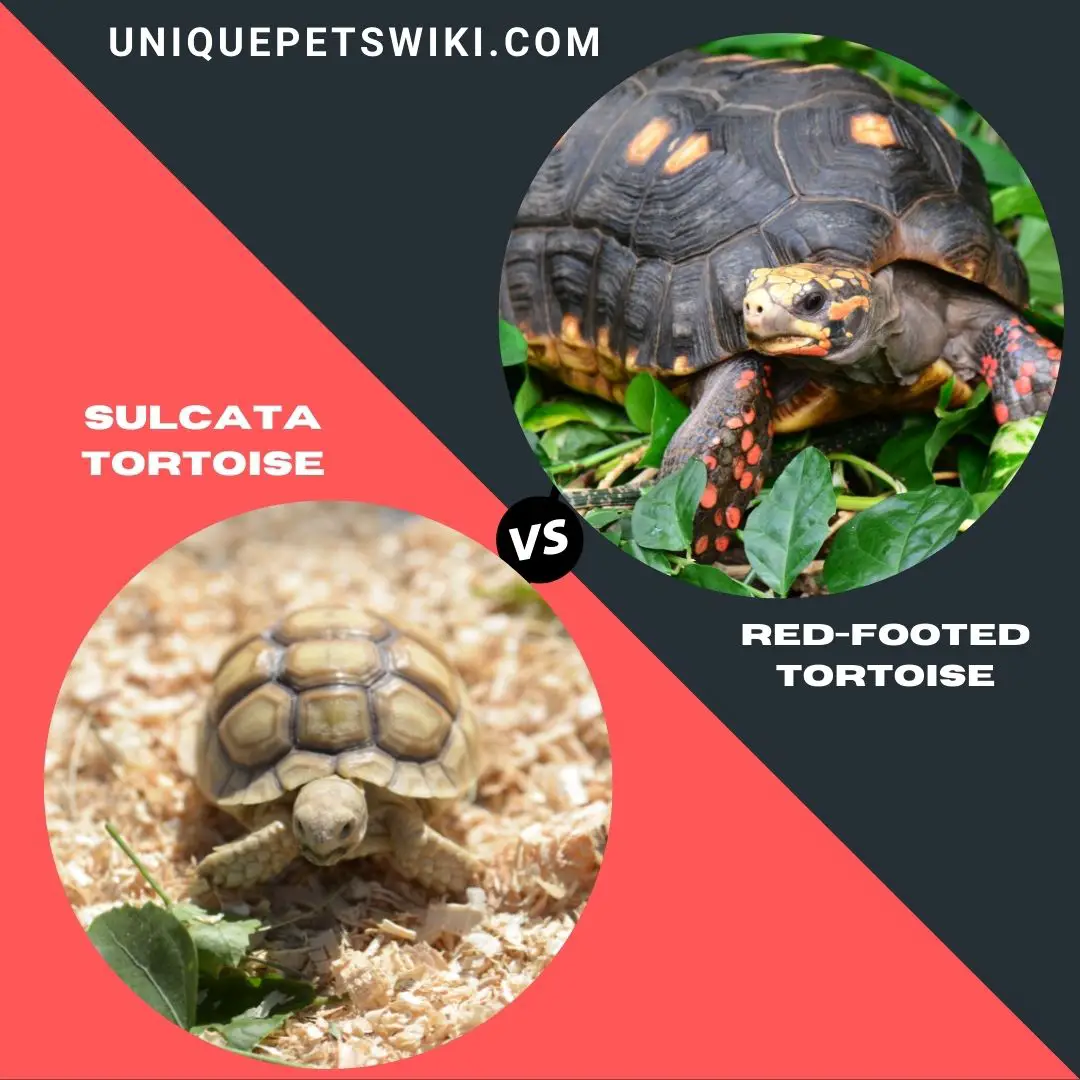Sulcata vs. Redfoot tortoises, which one? Are you having trouble making a good decision between these two species of tortoises? Then this article is for you.
Tortoise is an ideal reptile for hobbyists looking for a pet that does not shed. Both Sulcata and Redfoot tortoises are among the most common and popular reptiles you can keep as pets. They are known as a hardy pet and have a low-maintenance level.
However, you will need to provide them with suitable habitat and quality care to keep them happy and healthy. The two tortoise species offer different options, and you may be wondering which of them will be more suitable for you.
In this article, we will help highlight some of the similarities and differences between these two species to help make your decision easy.
Contents
Sulcata vs. Redfoot Tortoise As Pets
Both Sulcata and Redfoot tortoises are considered by many to be docile, friendly, calm, and active as a pet.
Sulcata tortoises are curious and docile tortoises, making them suitable for all types of hobbyists. They are known to be very sociable and can form a relationship with their owner. However, they are more suitable for you if you live in a warm area with a large yard.
Redfoot tortoise is a docile and easy-going reptile but does not do well with handling. However, they are very sociable reptiles, and you can raise them in pairs or small groups.
Although you can keep them both indoors and outdoors, they need a lot of space to roam and graze, and it is best to keep them outdoors.
Sulcatas are very slow growers and are known to reach a full adult size between 15-20 years. They can grow to about 24-30 inches, and the males are usually larger than the females. On the other hand, redfoot tortoises can grow to about 11-14 inches when they clock ten years old.
In the sections below, we will explore some of the unique differences between these two species. Keep reading.
Sulcata vs. Redfoot Tortoise: Full comparison
When it comes to what makes the best pet, most people consider a long lifespan, small size, friendly, docile, hardy, low cost of maintenance, and easy care requirements. We have put some of these factors into consideration to help compare these two tortoise species.
This full comparison will help to guide you to choose between Sulcata and Redfoot tortoise. Enjoy!!!

Lifespan
Both tortoises species are suitable for reptile owners ready for a long time commitment. Sulcata tortoises can live for more than 100 years under optimal care. Furthermore, the Redfoot tortoise can live for about 90 years under optimal care.
Habitat
Sulcata tortoises originate from the southern part of the Sahara, and you can easily find them in the deserts and grasslands of northern Africa. You will need to simulate the condition of the arid desert whether you are keeping them indoors or outdoors.
You can only house baby and juvenile Sulcata tortoises indoors until they are large enough to escape from predators. You can then create an outdoor pen with soils for burrowing once they reach two years old or 8 inches in size.
Their outdoor enclosure needs to be about 100 square feet with a 12 inch-wall to help prevent them from escaping. Sulcatas are great climbers, and you can include logs, rocks, and other features where they can climb in their enclosure.
You can also provide them with a shallow water dish and hiding places.
Red foot tortoise originates from Central and South America and is commonly found in the grasslands and forests. This means you will need to provide them with high humidity, lots of covers, and a moderate temperature.
Furthermore, they need a lot of soil where they can burrow. You can easily keep hatchlings and juvenile Red foot tortoises in a 50-gallon tank. However, you will need a 30-40 square feet indoor or outdoor enclosure for a full-grown redfoot tortoise.
You can keep them in an outdoor pen that has a wire roof and is 2 feet tall, and you need to ensure the walls of their tank are sturdy.

Size
Sulcata hatchlings are usually about 2 inches in size. They are considered slow-growing animals. They will grow to about 7 inches after a year and gain 5-10 pounds. However, they will reach maturity at 15-20 years and will grow to about 24-30 inches in size.
However, Redfoot tortoises are about 2 inches in length during the hatchling stage and will grow by 1-2 inches every year once they reach the adult stage and will grow to about 11-14 inches in size when they clock ten years old.
Redfoot tortoise also displays sexual dimorphic characteristics as the males are known to be larger than the females.
Weight
From the discussion above, you will see that sulcata tortoises weigh more than the redfoot tortoise. Sulcata tortoises usually weigh about 80-150 pounds and are 2.5-3 feet wide. They can easily destroy lots of things whether they are kept indoors or outdoors at this size.
However, the Redfoot tortoise usually weighs 20-30 pounds, but the largest documented species of redfoot is 60 pounds.
Looks
It all depends on your choice when it comes to which species is more appealing between Sulcata and redfoot tortoise.
Sulcata tortoises have yellowish skin with tan to the brown shell, which helps them to blend into their native sandy desert environment. However, there are ivory and albino sulcata tortoise morphs with a lighter color.
You will find two or three spurs on their thighs, and they have oval-shaped shells with well-defined grooves.
Redfoot tortoises have bright colorations, which is among the reasons they are popular. You can easily identify them with their unique red, yellow, and orange markings on their feet, legs, tail, and head. They have dark brown to black shells, and each scute has a lighter center and darker periphery, unlike the Russian tortoise.
Active Level
Sulcata tortoise is unbelievably a very active reptile even with its large size. They are also known as living bulldozers because they can dig long tunnels of several yards in their outdoor enclosure. Furthermore, they usually graze for hours under cooler temperatures.
Once the temperature gets hotter, they will start to dig burrows to hide from the sun. They also bask in the sun in the morning to help raise their body temperature after a cool evening.
Redfoot tortoises are usually active during the day, unlike most desert tortoise breeds. They are known to spend their time digging and foraging for food. After eating a large meal, they usually spend some time resting before they start eating again.
Redfoot tortoise is also a prolific burrow and usually digs to cool down from the heat, seek shelter, and hide from predators. Furthermore, they love exploring their environment and will remember the location of their fruit trees, water sources, and other things in their enclosure.
Diet
Sulcata tortoises usually feed on green grasses and leaves rich in fiber but low in protein. However, they have a wide variety of food to feed on as they eat fruits and flowers occasionally.

Their food sources are readily available, and you will not have any difficulty when it comes to feeding them as pets. They are not picky eaters like other reptiles and eat in large quantities like a cow.
Redfoot tortoises are omnivorous reptiles. Their diet in the wild is mainly herbivores and comprises leafy plants, grasses, fungi, flowers, and fruits. However, they occasionally feed on small and slow-moving invertebrates.
You can feed them with 60% greens, 30% fruits, and 10% vegetables in captivity. However, you need to ensure that the amount of greens you feed them equals their body size.

Brumation
Both Sulcata and redfoot tortoise do not brumate. However, they can slow down a bit to help them cope with the colder months but don’t completely brumate. Furthermore, they only dig holes to hide when the weather is too hot but not to hibernate.
This is because their systems are designed to tolerate low temperatures without having to hibernate. However, during the winter months, they will eat less but are still going to be active. It is best to avoid forcing them to hibernate in captivity; as a result, it may not be desirable.
Personality
The personality of a tortoise usually varies greatly between species and individual tortoises that are of the same species. However, both species of tortoises are docile, friendly and will make a perfect pet for beginner hobbyists.
Sulcata tortoises are not as sociable as redfoot tortoises as they are prone to aggression, especially males. Furthermore, females with eggs are also aggressive if they believe there is a threat to their eggs.
The males are aggressive towards each other, and it is best not to keep two or more male Sulcata tortoises together.
Although redfoot tortoises are not territorial, they can show signs of aggression during the mating season as the males fight for females. They are also known to communicate with each other through cluck.
Required Enclosure Size
You can keep hatchling and juvenile sulcatas in a 18x18x12 enclosure. However, you should keep in mind that this can only accommodate them for some months to 2 years. You will need an enclosure that is 80 square feet for housing an adult sulcata tortoise indoors.
This is why it is best to house them in an outdoor enclosure of about 100 square feet with 12 inch-wall to help prevent them from escaping. You should be ready to build a very big and strong enclosure if you want to house more than two adult sulcatas in an enclosure.
You can keep hatchling and juvenile redfoot tortoises in 50-gallon plastic or glass tanks. However, you will need a 30-40 square feet indoor or outdoor pen for your adult redfoot tortoise. This is because they will need a lot of room to roam around.
You can create an outdoor pen with a wire roof and walls that are 2 feet tall and around 6inches below ground to keep your redfoot without any issue.
Lighting, Heating, Humidity Requirements
In the wild, Sulcata tortoises are usually found in a hot arid environment and will need a high temperature with low humidity levels in captivity. The ideal temperature for Sulcata tortoises is between 77⁰F– 95⁰F during the day, and their basking spot temperature should not be more than 122⁰F.
Furthermore, the night temperature in their enclosure should not go below 63⁰ F.
Redfoot also needs a thermal gradient to help keep their body temperature at an optimal level. The ideal temperature for red foot tortoise, whether indoor or outdoor, should be around 85F to 90F. They also need a basking spot temperature of about 95F
Furthermore, the nighttime temperature in their enclosure should not go below 70°F.
Suitability For Beginners
Both tortoises are suitable for beginner hobbyists if we go by the factors discussed in this article. However, you may not be able to handle Sulcata tortoises once they become adults. Furthermore, redfoot tortoises do not like handling.
Costs
Sulcata tortoises usually cost around $100-$200 at a pet shop. However, you can also find them for free from people that want to rehome them. You will find them available for rehoming because they are very popular tortoises with a long lifespan and can live for more than 100 years.
The redfoot tortoise usually costs between $150-$300 at the pet store. However, you can check with local rescue groups and wildlife centers before buying them from a pet shop. This is because many are looking to be rehomed or abandoned due to their long lifespan.
Ability To Keep In Groups
Although you can house more than one Sulcata tortoise together in a single enclosure, they are known to be aggressive to each other. Redfoot tortoise is a social reptile, and you can easily house more than one redfoot tortoise together without any issue.
However, you should be ready to spend hundreds of dollars on setting up an enclosure that will have enough space to accommodate them.
Can You Keep Sulcata and Redfoot Tortoise Together?
It is best to avoid housing different species of tortoises in the same enclosure for several reasons, like behavioral differences and the potential spread of diseases. You should avoid keeping both Sulcata and Redfoot tortoise together in the same cage.
Furthermore, keeping them together can lead to potential confrontation and injury.
Wrapping Up
Reptile enthusiasts need to research the species of tortoise that they want to help them determine the species that best fits your location, personality, budget, and space.
This comparison guide will help you to understand the similarities and differences between sulcata and Redfoot tortoise to help you decide which one suits you best.
